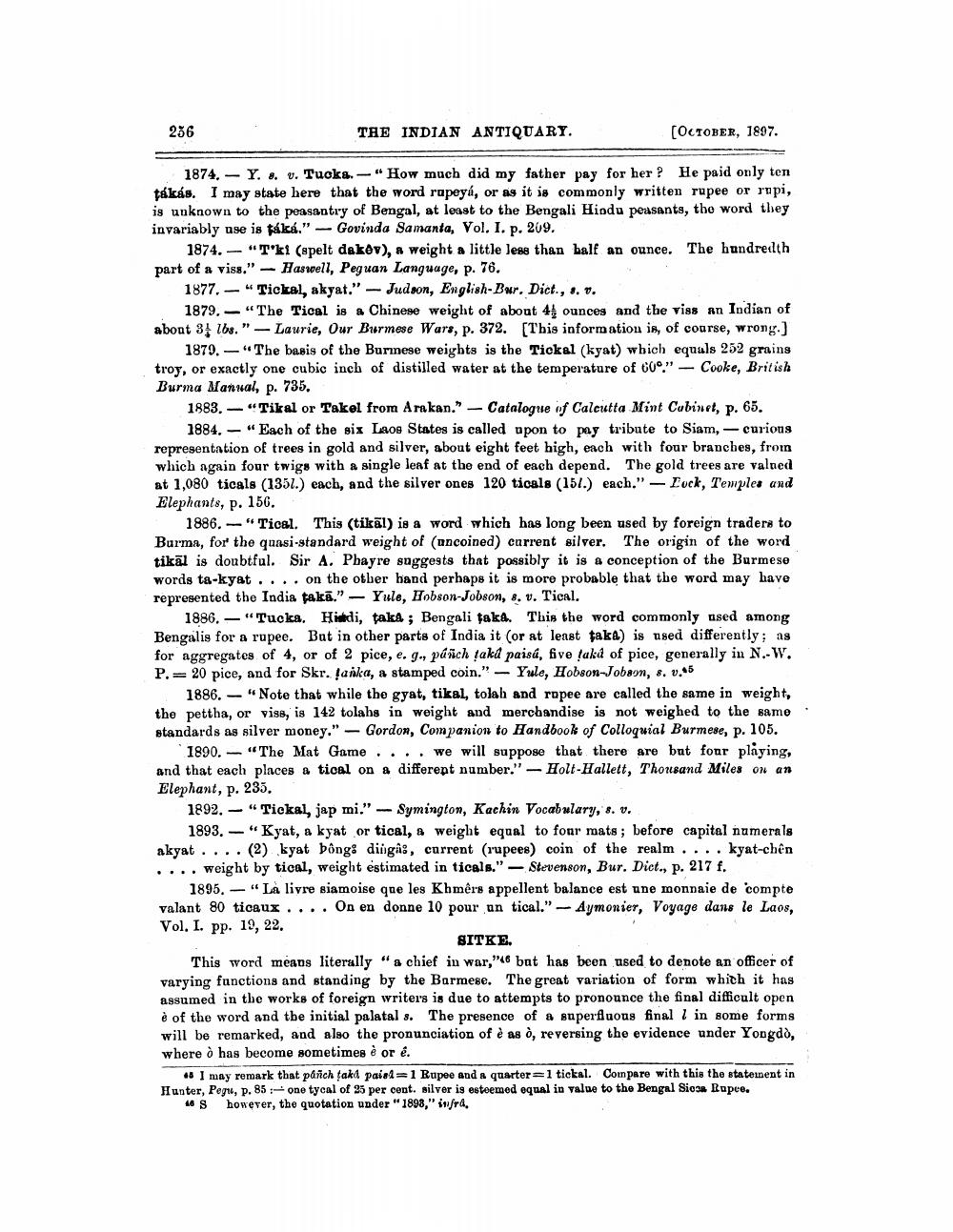________________
256
THE INDIAN ANTIQUARY.
(OCTOBER, 1897.
1874. - Y. 8. v. Tuoka. - "How much did my father pay for her ? He paid only ten tákás. I may state here that the word rapeyá, or as it is commonly written rupee or rupi, is unknown to the peasantry of Bengal, at least to the Bengali Hiodu peasants, the word they invariably use is táká." - Govinda Samanta, Vol. I. p. 209.
1874. - "T'ki (apelt dakov), a weight a little less than half an ounce. The hundredth part of a viss." - Haswell, Peguan Language, p. 76.
1877. - "Tickal, akyat." - Judson, English-Bur. Dict., 5.1.
1879,- "The Tical is a Chinese weight of about 44 ounces and the viss an Indian of about 3 lbs." - Laurie, Our Burmese Wars, p. 372. [This information is, of course, wrong.)
1879. - "The basis of the Burnese weights is the Tickal (kyat) which equals 252 grains troy, or exactly one cubic inch of distilled water at the temperature of 60°." - Cooke, British Burma Manual, p. 735.
1883. - "Tikal or Takol from Arakan." - Catalogue of Calcutta Mint Cabinet, p. 65.
1884. - "Each of the six Laos States is called upon to pay tribute to Siam, - curious representation of trees in gold and silver, about eight feet high, each with four branches, from which again four twigs with a single leaf at the end of each depend. The gold trees are valned at 1,080 ticals (1351.) each, and the silver ones 120 ticals (15l.) each." - Lock, Temples and Elephants, p. 156.
1886.-"Tical. This (tikāl) is a word which has long been used by foreign traders to Burma, for the quasi-standard weight of (uncoined) current silver. The origin of the word tikāl is doubtful. Sir A. Pbayre suggests that possibly it is a conception of the Burmese words ta-kyat .... on the other band perhaps it is more probable that the word may have represented the India takā." - Yule, Hobson-Jobson, 8. v. Tical.
1886. - "Tucka. Histdi, taka ; Bengali taka. This the word commonly ased among Bengalis for a ropee. But in other parts of India it (or at least taka) is used differently; as for aggregates of 4, or of 2 pice, e. g. pásich takd paisá, five takd of pice, generally in N.-W. P.= 20 pice, and for Skr. Janka, a stamped coin." -- Yule, Hobson-Jobson, 8. v.15
1886. - "Note that while the gyat, tikal, tolah and ropee are called the same in weight, the pettha, or vise, is 142 tolabs in weight and merchandise is not weighed to the same. standards as silver money." - Gordon, Companion to Handbook of Colloquial Burmese, p. 105.
1890. "The Mat Game .... we will suppose that there are but four playing, and that each places a tical on a different number." - Holt-Hallett, Thousand Miles on an Elephant, p. 235.
1892. - "Tickal, jap mi." - Symington, Kachin Vocabulary, 8. v.
1893. - "Kyat, a kyat or tical, & weight equal to four mats; before capital numerals akyat .... (2) kyat bông: dingas, current (rupees) coin of the realm....kyat-chen .... weight by tical, weight estimated in ticals." - Stevenson, Bur. Diet., p. 217 f.
1895. - "Là livre siamoise que les Khmêrs appellent balance est une monnaie de compte valant 80 ticaux.... On en donne 10 pour un tical." -Aymonier, Voyage dans le Laos, Vol. I. pp. 19, 22.
SITKE. This word means literally "a chief in war,"46 bat has been used to denote an officer of varying functions and standing by the Barmese. The great variation of form which it has assumed in the works of foreign writers is due to attempts to pronounce the final difficult open è of the word and the initial palatal s. The presence of a superfluous final l in some forms will be remarked, and also the pronunciation of è as Ò, reversing the evidence under Yongdo, where ò has become sometimes è or é.
45 I may remark that pánch takd paisl=1 Rupee and quarter=1 tickal. Compare with this the statement in Hunter, Pegro, p. 85:- ono tycal of 35 per cent. silver is esteemed equal in value to the Bengal Siosa Ropce.
18 S however, the quotation under "1898," infra.




